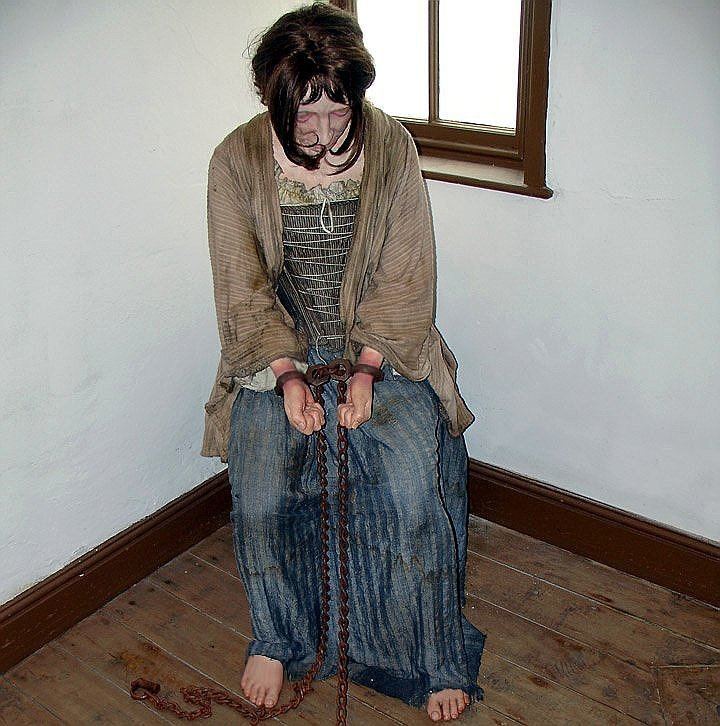 | ||
Physical restraint refers to means of purposely limiting or obstructing the freedom of a person's bodily movement.
Contents
Basic methods
Usually, binding objects such as handcuffs, legcuffs, ropes, chains, straps or straitjackets are used for this purpose. Alternatively different kinds of arm locks deriving from unarmed combat methods or martial arts are frequently used to restrain a person, which are predominantly used by trained police or correctional officers. This less commonly also extends to joint locks and pinning techniques.
The freedom of movement in terms of locomotion is usually limited, by locking a person into an enclosed space, such as a prison cell and by chaining or binding someone to a heavy or immobile object. This effect can also be achieved by seizing and withholding specific items of clothing, that are normally used for protection against common adversities of the environment. Examples can be protective clothing against temperature, hereby factually constraining the individual to remain in a sheltered spot. This also refers to taking away a person's shoes in a situation of captivity and forcing the individual to remain barefoot. The freedom of movement is practically restricted in many everyday situations without the protection offered by conventional footwear. Various ground textures in urban as well as natural areas can cause substantial physical distress for a shoeless person and hinder the locomotion. Ground textures consisting of crushed stone or similar construction aggregate can be practically impossible for a person to walk or run over without wearing shoes. Aside from extreme circumstances, an unshod person is steadily compromised by the usual imponderabilities of most surroundings and localities. Controlling the free movement of detainees by keeping them barefoot is therefore common practice in many countries. A main motive can be seen in the fact, that the principal effects of frustrating prison escape and curbing acts of resistance are obtained without cost and with only minimal effort. Further it is an effective complementation of binding restraints.
British police use
British Police officers are authorised to use leg and arm restraints, if they have been instructed in their use. Guidelines set out by the Association of Chief Police Officers dictate that restraints are only to be used on subjects who are violent while being transported, restraining the use of their arms and legs, minimising the risk of punching and kicking. Pouches carrying restraints are usually carried on the duty belt, and in some cases carried in police vans.
For restraint for medical or psychiatric purposes, see medical restraint.
Purpose
Physical restraints are used:
- approximately 70 % of teachers who work with students with behavioral disabilities use a type of physical restraint (Goldstein & Brooks, 2007)
- often used in emergency situations or for de-escalation purposes (Ryan & Peterson, 2004)
- many educators believe restraints are used to maintain the safety and order of the classroom and students, while those who oppose their use believe they are dangerous to the physical and mental health of children and may result in death (McAfee, Schwilk & Miltruski, 2006) and (Kutz, 2009).
- Individuals with Disabilities Education Act has stated that "Restraints may not be used as an alternative to adequate staff" (McAfee, Schwilk & Miltruski, 2006, p. 713). Also, "restraint may be used only when aggressive behavior interferes with an individual's own ability to benefit from programming or poses physical threat to others" (McAfee, Schwilk & Miltruski, 2006, p. 713).
- restraints were developed during the 1700s by Philippe Pinel and performed with his assistant, Jean-Baptiste Pussin in hospitals in France
Misuse and risks of physical restraints
Restraining someone against their will is generally a crime in most jurisdictions, unless it is explicitly sanctioned by law. (See false arrest, false imprisonment).
The misuse of physical restraint has resulted in many deaths. Physical restraint can be dangerous, sometimes in unexpected ways. Examples include:
For these and many other reasons, extreme caution is needed in the use of physical restraint.
Gagging a restrained person is highly risky, as it involves a substantial risk of asphyxia, both from the gag itself, and also from choking or vomiting and being unable to clear the airway. In practice, simple gags do not restrict communication much; however, this means that gags that are effective enough to prevent communication are generally also potentially effective at restricting breathing. Gags that prevent communication may also prevent the communication of distress that might otherwise prevent injury.
Medical restraints
A survey in the US in 1998 reported an estimated 150 restraint related deaths in care environments (Weiss, 1998). Low frequency fatalities occur with some degree of regularity. An investigated of 45 restraint related deaths in US childcare settings showed 28 of these deaths were reported to have occurred in the prone position. In the UK restraint related deaths would appear to be reported less often. The evidence for effective staff training in the use of medical restraints is at best crude, with evaluation of training programmes being the exception rather than the rule. Vast numbers of care staff are trained in ‘physical interventions’ including physical restraint, although they rarely employ them in practice. It is accepted that staff training in physical interventions can increase carer confidence.
The Millfields Charter is an electronic charter which promotes an end to the teaching to frontline healthcare staff of all prone (face down) restraint holds. In June 2013 the UK government announced that it was considering a ban on the use of face-down restraint in English mental health hospitals.
